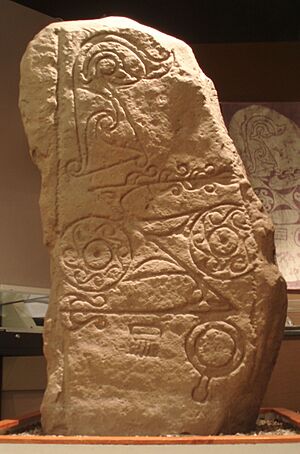Dunnichen Stone facts for kids
Quick facts for kids The Dunnichen Stone |
|
|---|---|

The Dunnichen Stone
|
|
| Material | Old Red Sandstone |
| Height | 1.5 metres (4.9 ft) |
| Symbols |
|
| Created | Seventh Century CE |
| Discovered | 1811 |
| Place | near Dunnichen, Angus, Scotland |
| Present location | Meffan Institute, Forfar, Angus, Scotland |
| Coordinates | 56°38′39″N 2°53′21″W / 56.6441°N 2.8891°W |
| Classification | Type I |
| Culture | Picto-Scottish |
The Dunnichen Stone is an ancient stone from Scotland. It was made by the Picts, a group of people who lived in Scotland long ago. This special stone was found in 1811 near Dunnichen in Angus. Experts believe it was carved around the 600s AD. It is a Pictish symbol stone and is very important for understanding Pictish art.
Contents
Where Was the Dunnichen Stone Found?
We don't know the exact spot where the stone was first found. People think it was in a field called East Mains of Dunnichen. This field is on the southeast side of Dunnichen Hill. It looks out over an area called Dunnichen Moss. Today, you can see the Dunnichen Stone at the Meffan Institute in Forfar.
The Stone's Journey Through Time
The Dunnichen Stone has moved around a lot since it was found. When it was first discovered, it was put up at a church. This church might have been in Dunnichen or in Letham.
Later, the stone was moved to the garden of Dunnichen House. In 1967, it went to the St Vigeans Museum. Then, in 1972, it moved to the Dundee Museum. This museum is now called the McManus Galleries. Today, the stone is on a long-term loan. It is displayed at the Meffan Institute in Forfar. A copy of the stone stands at the Church in Dunnichen.
What Does the Dunnichen Stone Look Like?
The Dunnichen Stone is made of rough sandstone. It stands about 1.5 meters (4 feet 8 inches) tall. It is 0.7 meters (2 feet 3 inches) wide. The stone is 0.3 meters (1 foot) thick.
One side of the stone has three special symbols carved into it:
- A Pictish flower
- A double disc and Z-rod
- A mirror and comb
The double disc and Z-rod, and the mirror and comb symbols, are quite common. You can see them on other Pictish stones. For example, they appear on the Aberlemno Serpent Stone. However, the flower symbol is much rarer. This makes the Dunnichen Stone even more unique.
See also
 In Spanish: Piedra de Dunnichen para niños
In Spanish: Piedra de Dunnichen para niños

